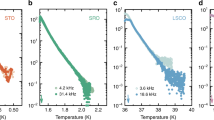Abstract
The structure and dynamics of froths have been subjects of intense interest owing to the desire to understand the behaviour of complex systems where topological intricacy prohibits exact evaluation of the ground state. The dynamics of a traditional froth involves drainage and drying at the cell boundaries; thus, it is irreversible. Here, we report a new member of the froth family: suprafroth, in which the cell boundaries are superconducting and the cell interior is normal, or non-superconducting. Despite having a very different microscopic origin, topological analysis of the structure of the suprafroth shows that the same statistical laws, such as those of von Neumann and of Lewis apply to a suprafroth. Furthermore, for the first time in the analysis of froths, there is a global measurable property, the magnetic moment, which can be directly related to the suprafroth structure. We propose that this suprafroth is a model system for the analysis of the complex physics of two-dimensional froths—with magnetic field and temperature as external (reversible) control parameters.
This is a preview of subscription content, access via your institution
Access options
Subscribe to this journal
Receive 12 print issues and online access
$209.00 per year
only $17.42 per issue
Buy this article
- Purchase on Springer Link
- Instant access to full article PDF
Prices may be subject to local taxes which are calculated during checkout






Similar content being viewed by others
References
Weaire, D. & Hutzler, S. The Physics of Foams (Oxford Univ. Press, New York, 1999).
Elias, F., Flament, C., Bacri, J.-C. & Francer, F. in Foams and Emulsions (eds Sadoc, J. F. & Rivier, N.) 91–104 (NATO ASI Series, Series E: Applied Sciences, Vol. 354, Kluwer, Dordrecht, 1999).
Elias, F., Drikis, I., Cebers, A., Flament, C. & Bacri, J.-C. Undulation instability in two-dimensional foams of magnetic fluid. Eur. Phys. J. B 3, 203–209 (1998).
Weaire, D., Bolton, F., Molho, P. & Glazier, J. A. Investigation of an elementary model for magnetic froth. J. Phys. Condens. Matter 3, 2101–2114 (1990).
Prozorov, R. Equilibrium topology of the intermediate state in type-I superconductors of different shapes. Phys. Rev. Lett. 98, 257001 (2007).
Prozorov, R., Giannetta, R. W., Polyanskii, A. A. & Perkins, G. K. Topological hysteresis in the intermediate state of type-I superconductors. Phys. Rev. B 72, 212508 (2005).
Landau, L. The intermediate state of superconductors. Nature 141, 688 (1938).
Cēbers, A., Gourdon, C., Jeudy, V. & Okada, T. Normal-state bubbles and lamellae in type-I superconductors. Phys. Rev. B 72, 014513 (2005).
Huebener, R. P. Magnetic Flux Structures of Superconductors 2nd edn (Springer, New York, 2001).
Lewis, F. T. The correlation between cell division and the shapes and sizes of prismatic cells in the epidermis of cucumis. Anat. Rec. 38, 341–362 (1928).
Rivier, N. in Foams and Emulsions (eds Sadoc, J. F. & Rivier, N.) 105–125 (NATO ASI Series, Series E: Applied Sciences, Vol. 354, Kluwer, Dordrecht, 1999).
Poole, C. J., Farach, H., Creswick, R. & Prozorov, R. Superconductivity 2nd edn (Elsevier (Imprint: Academic Press), Amsterdam, 2007).
MacPherson, R. D. & Srolovitz, D. J. The von Neumann relation generalized to coarsening of three-dimensional microstructures. Nature 446, 1053–1055 (2007).
Von Neumann, J. Metal Interfaces 108–110 (American Society for Metals, Cleveland, 1952).
Elias, F., Flament, C., Glazier, J. A., Graneri, F. & Jiang, Y. Foams out of stable equilibrium: Cell elongation and side swapping. Phil. Mag. B 79, 729–751 (1999).
Acknowledgements
We thank J. Clem, N. Goldenfeld, R. Huebener, V. Kogan, R. Mints and J. Schmalian for helpful discussions. Work at the Ames Laboratory was supported by the Department of Energy, Basic Energy Sciences under Contract No. DE-AC02-07CH11358. R.P. acknowledges support from NSF Grant Number DMR-05-53285 and the Alfred P. Sloan Foundation.
Author information
Authors and Affiliations
Contributions
R.P. idea, measurements, data analysis; A.F.F. measurements, data analysis; J.R.H. measurements; P.C.C. idea, data analysis.
Corresponding author
Supplementary information
Supplementary Information
Supplementary Figure 1 (PDF 715 kb)
Supplementary Information
Supplementary Video 1 (MOV 2199 kb)
Supplementary Information
Supplementary Video 2 (MOV 3435 kb)
Rights and permissions
About this article
Cite this article
Prozorov, R., Fidler, A., Hoberg, J. et al. Suprafroth in type-I superconductors. Nature Phys 4, 327–332 (2008). https://doi.org/10.1038/nphys888
Received:
Accepted:
Published:
Issue Date:
DOI: https://doi.org/10.1038/nphys888
This article is cited by
-
Irreversibility in Rolled Tantalum
Journal of Superconductivity and Novel Magnetism (2018)
-
Microfluidic manipulation of magnetic flux domains in type-I superconductors: droplet formation, fusion and fission
Scientific Reports (2017)
-
Neutron Dark-Field Imaging of the Domain Distribution in the Intermediate State of Lead
Journal of Low Temperature Physics (2016)
-
Visualizing the morphology of vortex lattice domains in a bulk type-II superconductor
Nature Communications (2015)
-
Type-1.5 Superconductivity in Multiband and Other Multicomponent Systems
Journal of Superconductivity and Novel Magnetism (2013)



